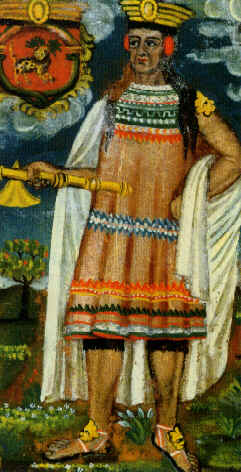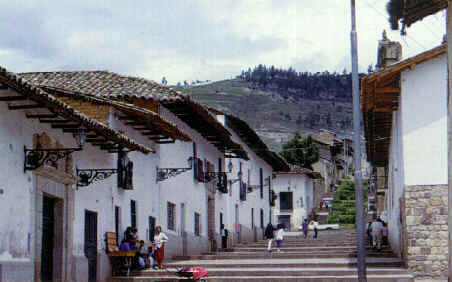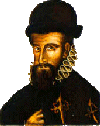|
Documentaries
Press
|
Rated 1.62/5
|
The Conquest of the Inca Empire
Part 2
IV from jealousy to civil war
What had happened in those three years? It started when the Sapa Inca in 1524 at the peak of his power heard rumours of men in silver clothes traveling on floating fortresses and with hear on their chin. In those years the ruling Inca Huayna Capac had predicted his downfall and that of the empire. The rulers of Tawaintisuyu had no good feeling concerning these foreigners. The Inca died two years after the first Spanish visit to the country. Supposedly he suffered variola, a European disease brought by the Spanish. The unknown epidemic had already taken countless victims. One of them was their ruler who fell to the strange sickness. Dispute about his successor was an effect of it. Usually the eldest full blooded son of the Inca and the queen the Ccoya (his sister) was choosen. So the nobility of Cuzco had choosen Huascar as the new Sapa Inca, the new Inca.
 A
large part of the royal suite was itself no longer in Cuzco, but in Quito, that had
been conquered by his father who choose to stay there the last years of his life.
Quito had become a second capital. The army, stationed in Quito, preferred the brother
of Huascar, Atahualpa as the new Sapa Inca to govern (see picture to the left). Atahualpa
had helped his father many times on the battle fields and they celebrated large victories.
Atahualpa remained in Quito and ignored the invitation of his brother to come to
honour him to Cuzco. Instead he sent presents and envoys over and over again to his
brother. He feared that friends of Huascar would assassinate him if he left quito.
A
large part of the royal suite was itself no longer in Cuzco, but in Quito, that had
been conquered by his father who choose to stay there the last years of his life.
Quito had become a second capital. The army, stationed in Quito, preferred the brother
of Huascar, Atahualpa as the new Sapa Inca to govern (see picture to the left). Atahualpa
had helped his father many times on the battle fields and they celebrated large victories.
Atahualpa remained in Quito and ignored the invitation of his brother to come to
honour him to Cuzco. Instead he sent presents and envoys over and over again to his
brother. He feared that friends of Huascar would assassinate him if he left quito.
Atahualpa was enormously feared by all who came close to him. He decided over life and death and could act mercilessly. Even the nobility trembled on their legs when Atahualpa asked to come over to visit him, fearing for not pleasing him. But the Sapa Inca remained Huascar.
One day Huascar demanded his brother to honour him and again there were evoys and presents send by Atahualpa. In place, Huascar arrested them because of the pressure of his court, the envoys had been imprisened, tortured and brought to death. As a result, Huascar send an army to capture Atahualpa who in turn became furious and took up the weapons. Tawantisuyu, already heavily tortured by the variola epidemic, trew itself into a bloody civil war where none was made prisoner of war.
After the first battles the troops under Huascar claimed victory because Atahualpa was caught and imprisoned. But amazinly he could escape and surrounded himself with his best trained army from Quito. The following battles were won by Atahualpa and his army. Huascar sent a second army who was less trained. After a decessive battle taking a couple of days they were beaten to the last men. This time the doors were open for Atahualpa to take his revance. His army moved to Cusco to take advantage of the situation and to imprison Huascar.
Underway they suffered some losses because of ambushes organized by Huascar's men, but then Atahualpa considered an ambush in a valley. With ease was the army of Huascar closed in and went on the run, the Sapa Inca was caught and imprisoned. His army was chased away and Atahualpa continued with his men in the direction of Cuzco to take power. He knew no mercy. Huascar's women were assassinated in front of his eyes, his noblicity and consultants were imprisoned or their throat were cut and their heads pinned on poles and left along the roads leading to Cuzco, a warning for everybody who dared to doubt the power of the new ruling Inca. Huascar was locked up in the fortress of Jauja .
V the conquistadores on gone to Cajamarca
When Pizarro, with his 160 heavily armed soldiers arrived in Tumbes they only encountered chaos and death. The men were discouraged by the events. Tumbes had suffered severely under the variola epidemic and the civil war. Together with Pizarro was a friend Almagro who joined him in two previous expeditions. Of the 160 adventurers there were 67 horseback riders and a vast weapon arsenal, among with lances, picks, muskets and artillery made available by Karel V. Pizarro was one of the only onces who realized that the situation was not hopeless but on the contrary, in the advantage of the Spanish. They stayed for 5 months in the city of Tumbes. Food was obtained mainly by plundering royal warehouses. Meanwhile Pizarro informed himself well. It came to his knowledge that the new Sapa Inca himselves was in the city of Cajamarca on a 14 days travel from the coast. One day the men left in that direction, with them the Indian interpreters who were captured some years before.
Underway the Spanish admired the works of the Incas. How deeper they went into the slopes of the Andes, how inhospitable the region became. The roads were nevertheless been built well and had even been maintained during the war years. Some valleys were crossed by bridges made of ichu-gras, mountain passes along ravines were so deep that the horsemen had to accompanion their horses by hand. The slightest misstep would be fatal. Shortly after the beginning of this almost hopeless venture, nine soldiers already returned to Tumbes, but the rest continued the excursion to the absolute unknown. They were all the time impressed by the perfectly organized road network, paved and at least one side provided with trees to ensure shade in this hot desert of the Peruvian coast side. Small artificial rivers followed the road, so that travellers always had water available. One of the Spanish later wrote: "such superb roads were nowhere to be found in the Christian civilisation especially not in mountain areas such as in Peru."
Meanwhile Atahualpa had stationed himself in Cajamarca, a place loved by the Inca nobility for its mild hot water springs that still exist today and are in use. Messengers returned with reports that the hairy men arrived with their floting fortresses and were on their way to Cajamarca to meet with the Sapa Inca. Atahualpa send some envoys to the Spanish to invite him for a meeting. A mere 200 men could impossibly endanger him. This is were the impressive insight of the illiterate Pizarro becomes obvious. The envoys were well received by the Spanish and were told that they are no warriers and that they came in peace, only 200 Inca warriers would be sufficient to overcome them. Pizarro offered presents and they talked about peace. Because of their message the Spanish could continue their voyage without being restrained in any way.
The altitude of the Andes hollowed the moral of the Spanish troops and their strenght to continue. Stooped under their heavy armor and weapons and gasping to breath in thin air they continued their precarious adventure. From time to time they encountered fortresses. All of them were empty, to their relief, thanks to the civil war that just ended. On the 15th of November they arrived at last in the valley of Cajamarca. Their joy vanished very quickly. On the mount ridges around the city they could see so many Inca-soldiers that the Spanish were filled with fear and dubiety. No one could return on their steps, at the smallest sign of weakness they would have been attacked by the warriers.
Pizarro led his men to the largest square in Cajamarca, surround by three long buildings with several doors. He sent a group of horse back riders to the palace under the guidance of Hernande da Soto to declare honour to Atahualpa and with an invitation of Pizarro to visit him. Inbetween raws of Inca-warriers the Spanish rode in the direction of the royal residence. On one hand they showed a fearless attitude, but their spirits were fulfilled with tension. On the inner court stood a basin in which cold and hot water flowed. There sat the Sapa Inca on his gouden chair surrounded by noblicity and his many women.
 A
nerve war between both parties started. De Soto knew how impressed the Incas were
of their horses. The Incas didn't know an animal bigger than the llama that could
carry no more than 40 kilos. He gallopped his nag right up to the Inca and stopped
right in front of the Sapa Inca. Saliva dripped on the royal outfit of the Inca but
he didn't move a muscle as a brave warrier behoved. The Spanish who following Da
Soto showed the same recklesness. Who would have shown fear should later be severely
punished by Pizzaro, with his life.
A
nerve war between both parties started. De Soto knew how impressed the Incas were
of their horses. The Incas didn't know an animal bigger than the llama that could
carry no more than 40 kilos. He gallopped his nag right up to the Inca and stopped
right in front of the Sapa Inca. Saliva dripped on the royal outfit of the Inca but
he didn't move a muscle as a brave warrier behoved. The Spanish who following Da
Soto showed the same recklesness. Who would have shown fear should later be severely
punished by Pizzaro, with his life.
After a long and strained silence the Sapa Inca started to adress the foreigners by means of the interpreters. He disapproved plundering his royal warehouses and the bad treating of some of his local leaders. The Spanish boasted with their military strength where "one horse is enough the conquer the whole empire ". At the coast they had battled with the Indians and the Spanish said they fought like women. They offered a military alliance with Atahualpa. Thereby the Sapa Inca agreed on the invitation to meet their leader Pizarro the day after, a mayor mistake as we will learn later.
This night would be the "longest night" of the Spanish adventure. As one of them told afterwards : "the hills were so full of Inca warriers that the lights of their camp fires looked like the starry sky."
| The end of an empire
External links
|
|
|
©2024 InfoPeru Best 1024 x 768 |
| Top | Cities | Machu Picchu | Inti Ramyi | Inca Trail | Incas | Email | Sitemap | About |
70702 visits
|
||||||||
